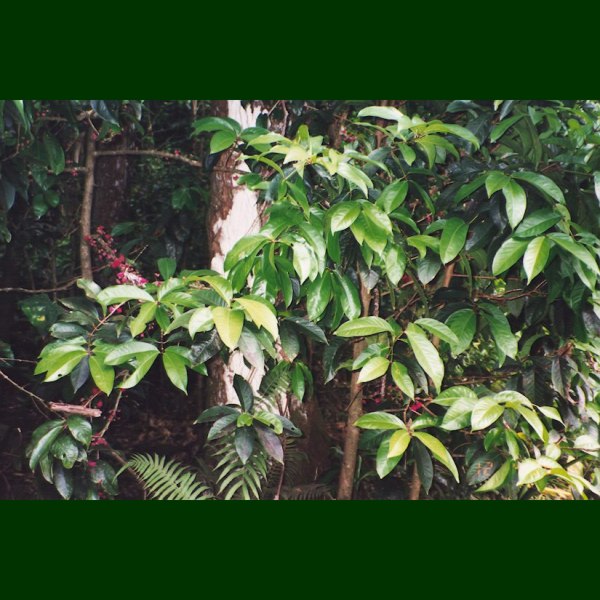 Hawaiian Name(s): ‘ōhi‘a ‘ai, ‘ōhi‘a, ‘ōhi‘a ‘ai ke‘oke‘o, ‘ōhi‘a hākea, ‘ōhi‘a kea, ‘ōhi‘a leo, ‘ōhi‘a ‘ula
Hawaiian Name(s): ‘ōhi‘a ‘ai, ‘ōhi‘a, ‘ōhi‘a ‘ai ke‘oke‘o, ‘ōhi‘a hākea, ‘ōhi‘a kea, ‘ōhi‘a leo, ‘ōhi‘a ‘ulaScientific Name: Syzygium malaccense
Vernacular Name: mountain apple, Malay apple
Family: Myrtaceae
Status: Polynesian introduction
Authority: (L.) Merr. & Perry
Description: Tree, to 20 m tall.
Habitat Occuring most commonly in mesic valleys at low elevations at mesic to wet sites mesic to wet sites between 200–310 (–550) m (Wagner et al. 1990:975–976).
Medicines: The bark is pounded with salt and strained through a niu leaf sheath (coconut, Cocos nucifera) for a topical medicine for open and deep cuts. For ‘ea (thrush) and pa‘ao‘ao the bark, leaves, and leaf buds are combined with kukui flowers (Aleurites moluccana), flowers, leaf buds, and leaves of the hinahina ku kahakai (Heliotropium anomalum var. argenteum), ‘aka‘akai ‘oliana bulbs (Allium cepa), leaves, leaf buds and flowers of the ‘uhaloa (Waltheria indica), and kō honua‘ula (red sugarcane, Saccharum officinarum),. The mixture is strained through the ‘ahu‘awa (Cyperus javanicus) and drunk. Foods suitable to consume while using this medicine are fish, lu‘au, kukui, ‘uala (sweet potato, Ipomoea batatas), and fresh poi. For hauna o ka waha (bad breath) and waha pala (coated mouth), the bark is combined with moa holokula (cf. Psilotum nudum) and kō kea (white sugarcane) (Chun 1994:225–226). The bark chewed for a sore throat. Leaves were crushed and ingested for bronchitis (Abbott 1992:101). It is a secondary ingredient in numerous other medications (see other plants)
Non Medicinal Uses: Fruit eaten (Lucas 1982:58; Malo 1951:21). Used at hula altars (kuahu) (Emerson 1909:19). Dyes made from inner bark of trunk and root (brown) as well as the fruit skin (red) (Krauss 1993:66). Wood for posts, house rafters, and enclosures for heiau (Wagner et al. 1990:976), as well as being used for carved idols (Rock 1913:321). In the Ethnology Collection at Bishop Museum there is a post-contact example of the wood made into a bowl.
Specific gravity of wood: unknown
Famous Locations:
Mele:
`Ōlelo Noeau: [I] Ka ua ho‘opala ‘ōhi‘a. The rain that ripens the mountain apples. The rain that comes just as the mountain apple is beginning to ripen. [II] Nawele ka maka o Hinaulu‘ohi‘a. Pale is the face of Hinaulu‘ohi‘a. Said of the pink rim around the blossom end of the white mountain apple. Refers to the goddess Hina. [III] ‘Ōhi‘a noho malu. Mountain apple in the shade. Said of a beautiful or handsome person, who is compared to a mountain apple that ripens to perfection in the shade. [IV] O Hinaia‘ele‘ele ka malama, ‘aluka ka pala a ka ‘ōhi‘a. Hinaia‘ele‘ele is the month when the mountain apples ripen everywhere.
Dye Color and Parts: Brown (inner bark of trunk, root), red (fruit skin)
Kino lau:
Location on Bishop Museum Kalihi Campus:
Propagation Information:
Seed: Seeds 25–35 mm. Photograph: H.Lennstrom.

Microscopy
Cross Section: Field of view: 2.6 mm x 1.6 mm. Photograph: H.Lennstrom.

Radial Section: Field of view: 2.6 mm x 1.6 mm. Photograph: H.Lennstrom.

Tangential Section: Field of view: 2.6 mm x 1.6 mm. Photograph: H.Lennstrom.

